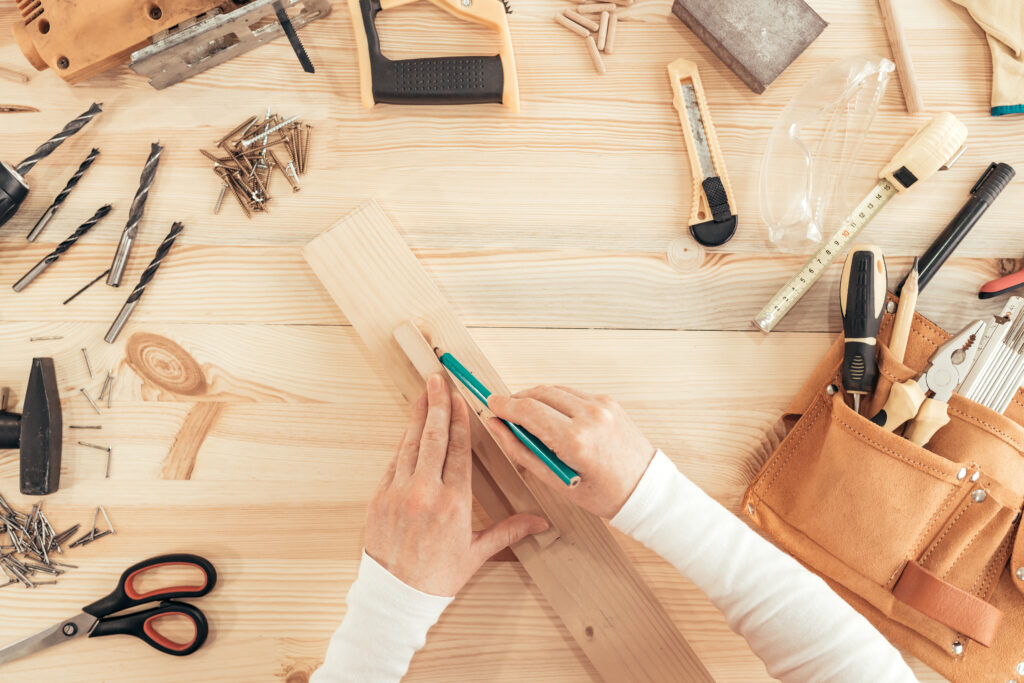
Top view of female carpenter hands working on desk in woodwork workshop
Are you ready to tackle some DIY projects around your home? Whether it’s a simple home improvement task or a bigger renovation project, the thought of doing it yourself can be both exciting and daunting. While taking on DIY projects can save money and give you a sense of accomplishment, they can also be overwhelming at times. To help make your home DIY projects more manageable, we’ve put together these seven tips that will guide you through the process and ensure success. So let’s get started!
Plan and Prioritize
Before you dive into any DIY project, it’s essential to make a plan. This can include creating a budget, making a list of materials needed, and setting a timeline for completion. It’s also a good idea to prioritize your projects based on their level of difficulty or urgency. By having a clear plan in place, you’ll have a better understanding of what needs to be done and when.
Gather the Right Tools and Materials
Having the correct tools and materials is crucial for any DIY project. Make sure to research and gather all the necessary items before starting, as this will save you time and frustration in the long run. Also, don’t be afraid to invest in quality tools that will last longer and make your projects easier.
One way to make your DIY projects more manageable is by using prefabricated materials, such as some from Prefab Technology Pty Ltd. These are pre-made components that can be easily assembled and installed, saving you time and effort. You can find prefabs for a variety of home improvement projects, such as cabinets, shelves, and even entire rooms like bathrooms or kitchens. They also come in a range of styles and price points, making them a great option for any budget.
Educate Yourself
While taking on a DIY project can be a fun learning experience, it’s essential to educate yourself beforehand. Watch tutorials, read articles, and ask for advice from friends or family who have experience in similar projects. This will help you avoid mistakes and ensure that your project turns out just as you envisioned.
Some DIY tasks may require more education and attention to detail than others. For example, electrical or plumbing work can be dangerous if not done correctly, so it’s crucial to watch tutorials or seek guidance from a professional before attempting these projects on your own.
Take Safety Precautions
DIY projects can involve using power tools and working with potentially hazardous materials. Before starting any project, make sure to read all safety instructions and wear appropriate protective gear. It’s also a good idea to have a first aid kit handy just in case.
When finding safety gear for your DIY projects, there are many options available. You can find protective eyewear, gloves, dust masks, and more at your local hardware store or online retailers. It’s essential to invest in quality gear that fits properly and meets safety standards.
Don’t Be Afraid to Ask for Help
While it’s admirable to want to do everything yourself, sometimes asking for help is necessary. If you’re feeling overwhelmed or unsure about a certain aspect of your project, don’t hesitate to reach out for assistance. This could be from a friend, family member, or even hiring a professional.
Lastly, don’t forget to thank anyone who has helped you with your DIY project. Showing appreciation for their time and effort can go a long way in maintaining good relationships and potentially getting help in future projects. You can do this by simply saying “thank you” or even offering to help them with a project of their own as a way of returning the favor. Remember, DIY projects are not just about accomplishing tasks but also building connections and community.
Break the Project Into Smaller Tasks
Large DIY projects can seem overwhelming at first glance. To make them more manageable, break the project into smaller tasks. This will not only help you stay organized but also give you a sense of accomplishment as you complete each task.
When breaking down a DIY project into smaller tasks, it’s important to consider the natural flow of the project. For example, if you’re renovating a room, start by removing old fixtures and then move on to painting walls before installing new flooring. This will make your tasks more efficient and save you from backtracking or redoing work. Additionally, make sure to take breaks in between tasks to avoid burnout and maintain focus.
Take Breaks and Have Fun
It’s easy to get caught up in the excitement and pressure of completing a DIY project, so be sure to take breaks and have fun along the way. Taking breaks will give your mind and body time to rest, preventing burnout. And remember, the whole point of DIY projects is to have fun and enjoy the process!
DIY projects can be a great way to personalize and improve your home while also being a fun and fulfilling experience. By planning, prioritizing, gathering the right tools, educating yourself, taking safety precautions, asking for help when needed, breaking down tasks, and taking breaks to have fun along the way, you’ll be well-equipped to take on any DIY project that comes your way. Good luck!


